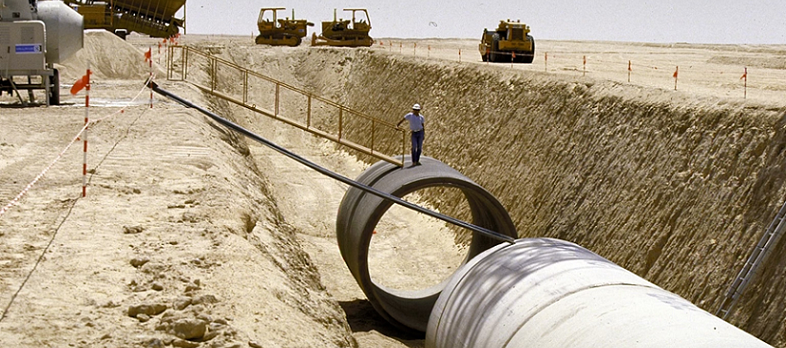Fossil water, also known as petrowater or paleowater, is a term used to describe underground water reserves that were formed during the last ice age. Over time, these layers were covered with more sediment, isolating the water from the surface for tens of thousands of years.
What Is Fossil Water?
Fossil water is an underground reservoir of water formed during the last glacial ice age. The name “fossil water” is borrowed from paleontology, as the water is trapped in rocks much like a traditional fossil. These ancient aquifers were created from melting ice and prehistoric lakes that seeped into water-porous rocks, silt, and sand underground. Over time, the layers of sediment covering these aquifers effectively sealed off the water from the surface for tens of thousands of years.
Fossil water is a type of non-renewable groundwater resource that is stored underground in deep aquifers. It is believed to be over 10,000 years old and has not been recharged by recent precipitation. It is different from modern groundwater in that it has been isolated from the surface for a long period of time and is not easily replenished.
Fossil water is considered an important resource in areas where fresh water is scarce, as it can be pumped to the surface and used for drinking, agriculture, and industrial purposes. However, because it is a finite resource, it is important to use it sustainably and ensure that future generations will have access to it as well.
There are some concerns about the quality of fossil water, as it may contain higher levels of dissolved salts and minerals, which can make it unsuitable for certain uses. Additionally, pumping large amounts of fossil water can cause the water table to drop, potentially leading to land subsidence and increased risk of contamination.

Why Fossil Water Is Important
Fossil water is important because it serves as a valuable source of water in regions where fresh water is scarce. It was formed during the last glacial ice age and has been trapped underground for thousands of years, providing a store of non-renewable water that can be used for a variety of purposes, including drinking, agriculture, and energy production.
Fossil water plays a crucial role in supporting economic development in areas with limited fresh water resources and can also serve as a backup source in the face of changing climate patterns. Despite its importance, it is important to use fossil water responsibly and sustainably to ensure its availability for future generations. Fossil water is considered important for several reasons:
- Limited fresh water resources: In some regions, fresh water is scarce, making fossil water an important source of water for drinking, agriculture, and industrial purposes.
- Irrigation: In areas with limited fresh water resources, fossil water can be used for irrigation, which is essential for agriculture and food production.
- Energy production: Fossil water is used in some energy production processes, such as hydrofracking for natural gas.
- Economic development: Access to water resources is critical for economic development, and in areas with limited fresh water, fossil water can play a key role.
- Climate change: Climate change is affecting the availability of fresh water in some regions, and fossil water can serve as a backup source in such areas

The Geology and Geography of Fossil Water
The geology and geography of fossil water is related to the formation of the underground aquifers that store the water. Fossil water is found in aquifers that were formed during the last glacial age, when melting ice and prehistoric lakes seeped into water-porous rocks, silt, and sand underground. Over time, these layers of sediment were covered and sealed off from the surface, isolating the water for tens of thousands of years.
Fossil water is found in various parts of the world, but it is most commonly found in arid and semi-arid regions where fresh water is scarce. These regions include the Middle East, North Africa, Australia, and parts of the western United States.
The geology of the region determines the quality of the fossil water, as some aquifers contain high levels of dissolved salts and minerals, making the water unsuitable for certain uses. The depth of the aquifers, the permeability of the surrounding rocks, and the rate at which water can be pumped also play a role in determining the viability of the resource.
Sustainability of Fossil Water
The sustainability of fossil water refers to the ability to use the resource in a way that meets current needs without compromising the ability of future generations to meet their own needs. In other words, it refers to the responsible and efficient use of the finite resource.
Fossil water is considered a non-renewable resource, as it has not been recharged by recent precipitation and is not easily replenished. Therefore, it is important to use it in a sustainable manner to ensure its availability for future generations. This can include:
- Managing pumping rates: Pumping large amounts of fossil water can cause the water table to drop, leading to land subsidence and increased risk of contamination. It is important to manage pumping rates to ensure the sustainability of the resource.
- Water quality: Some fossil water aquifers contain high levels of dissolved salts and minerals, which can make the water unsuitable for certain uses. It is important to monitor and manage water quality to ensure that the resource can be used in a sustainable manner.
- Water allocation: In some regions, water resources are scarce, and it is important to allocate water resources in a fair and equitable manner to ensure that all users have access to the resource.
- Conservation: Conserving water and reducing waste can help to ensure the sustainability of fossil water.

The Future of Fossil Water
The future of fossil water is dependent on several factors, including the rate of usage, climate change, alternative sources of water, and regulations. As a non-renewable resource, the continued pumping of fossil water at an unsustainable rate may lead to depletion, which could affect the availability of the resource for future generations.
Climate change may also impact the availability of water in some regions, and the development of alternative sources of water, such as desalination and recycling, could reduce reliance on fossil water in the future. Governments and international organizations may also implement regulations to ensure the sustainability of the resource. The future of fossil water is uncertain and will depend on how it is managed and used in the coming years.
- Climate change: Climate change is affecting the availability of fresh water in some regions, and it is unclear how this will impact the future of fossil water.
- Depletion: If fossil water is pumped at an unsustainable rate, the resource can become depleted, leading to reduced availability for future generations.
- Alternative sources: The development of alternative sources of water, such as desalination and water recycling, may reduce the reliance on fossil water in the future.
- Regulation: Governments and international organizations may implement regulations to manage the use of fossil water in the future, in order to ensure its sustainability.

